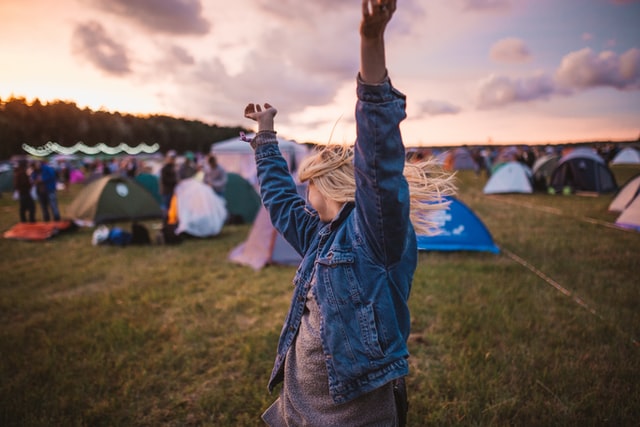Car camping is a blast. You get to create a make-shift home around like-minded people in the middle of nature all for the sake of listening to music. The best part? Your camp setup can be as simple or as creative as you’d like, showcasing tapestries, art, and comfy spaces for passers-by. However, there is a lot that goes into the packing process, which means there’s a lot you need to know before you go. Check out this quick guide to car camping and ensure you don’t leave anything behind.
What to know before you go
Car camping at festivals isn’t so different from regular camping. You need a lot of the same gear, and most venues provide basic amenities such as:
- Porta potties/pump-flush toilets
- Water refill stations
- Shower trailers (for an extra fee)
- General “store” with supplies and ice
- Lighted pathways
- Trash disposal
While these amenities are pretty common, every venue will be different. Before you go, it’s vital to research the area to which you are traveling, along with what’s provided at each site. Most music festival websites will have an FAQ or camping page that will clearly detail what to bring, what not to bring, what they offer for free, and what they offer for an added price. Once you have this information, you can start compiling your packing list.
Car camping checklist
What you’ll need for camping will always be dependent upon the location of the festival, the duration of your stay, the weather, and what the venue provides. Here is a basic checklist of items that you will most likely need for any venue.
Camping equipment
- Vehicle(s) that can hold all essential items
- Tent with stakes and tarp(s)
- Popup or canopy
- Sleeping bags, pillows, extra blankets, air mattress, sleeping pad
- Chairs
- Table(s)
- Cooler(s)
- Grill (if you plan on cooking for yourself; not necessary at all festivals)
- Tent lock(s)
Camping supplies
- Tools: rubber mallet, scissors (there may be a size limit), swiss army knife, can opener (if applicable), bottle opener
- Plates, utensils, cups, trash bags, paper towels
- Bins to wash dishes with soap/towels
- Lights, lanterns, flashlights, headlamps
- Batteries
- Car battery jump kit
- Decorative fairy lights
- Tapestries with clips/fasteners
- Sunscreen, bug spray
- Phone charger and battery packs
- First aid kit
- Hand sanitizer, baby wipes, etc.
- Music peaker
- Fan(s)
- Games: bocce, cornhole, polish horseshoes, can jam, etc.
- Extra car key
- Generator/portable battery to power electronics
- Kandi bracelet-making kit
Personal items
- Toothbrush, toothpaste, floss
- Face wash, hair/body care items
- Makeup
- Mirror
- Hairbrush/ties, bandana, hat, headbands, bobby pins
- Medication (Rxs, Tums, Tylenol/Advil, Benadryl, etc.)
- Earplugs, eye mask
- Towels (face/shower)
- Razors
- Feminine hygiene products
- Condoms
- Deodorant, lotions, perfumes
- Emergen-C, Airbourne, vitamins
- Sunglasses
- Small backpack or fanny pack (for inside the venue)
Clothing
- Tees, tanks, long sleeves (dependent upon location and weather)
- Pants, shorts (dependent upon location and weather)
- PJs (it usually cools down at night, even in the warmer areas)
- Socks, underwear, bras
- Rave gear/costumes
- Rain jacket
- Sweatshirt
- Comfy shoes/sneakers
- Flip flops/sandals
- Rain boots (depending on location/season)
- Bathing suit (if applicable)
Food and other necessities
This list will be dependent upon what you’re bringing with you, how many people are traveling in your group, and if you plan on purchasing food at the venue. Most venues, especially those with camping spaces, will have a marketplace or food court for campers with 24-hour food options. While this makes camping easy, it does mean you’re going to have to pay.
If you do choose to bring a grill, make sure you check the guidelines on the website. They may have grill types that are prohibited and/or size requirements.
Even if you don’t plan on bringing a grill, you’ll still need the basics. You don’t want to have to rely on the food court for all your needs, especially early in the morning or late at night. The food courts are also in a central location, so if your camping space is far away, you’ll have to plan to make that trek each time you want food. Here is a basic list to help you get started with food prep.
Nonperishables and non-refrigerated items
- Water bottle (for the refill station) and at least one case or jug for emergencies
- Gatorade/Poweraid/Propel packets or cases
- Snack items: crackers, chips, cookies, dried fruit, candy
- Fruit: bananas, oranges, pears, peaches, mangoes, etc.
- Bread, muffins, croissants, bagels
- Peanut butter, jelly, fluff, Nutella
- Nuts/trail mix/granola bars
- Jerky
- Alcohol (check the festival website, as every venue will have varying rules and restrictions)
Cooler foods
- Fruits: berries, grapes, pineapple
- Veggies: carrot sticks, cucumbers, tomatoes
- Cheeses: blocks and slices
- Dips: hummus, tzatziki, dressings, salsa
- Sandwich items, such as deli meats
Grilling items
- Proteins: hot dogs, sausages, wings, burgers, tips, meatless options such as veggie burgers, tempeh, Morning Star patties, etc.
- Veggies: asparagus, zucchini, summer squash, etc.
- S’mores stuff
- Propane tank(s), wood, coal
- Grill utensils
- Salt, pepper, oil/marinades, spices, Ziploc bags, aluminum foil
Basic car camping setup
There are a few ways to set up your campsite, and this will all depend on how many cars are in your caravan. If it’s one car, you have it made. Start by putting a tarp on the ground in the spot you plan to stake your tent. This will keep the bottom dry if it happens to rain.
Next, start building your tent. (If it’s your first time using this particular tent, it’s a good idea to enact a trial run at home before you leave.) Most tents come with stakes, but it’s always smart to buy extras to ensure the wind won’t blow your temporary home away. Seriously, you don’t want to be at the main stage while your tent literally blows away. It happens way more than you think! These mistakes can also cause a huge safety issue if a windy day or storm does happen to roll through. This is what they mean when they say “batten down the hatches”!
Lastly, use a popup canopy for sun/rain coverage. Place it over your tent to keep it cool/dry. Having more than one is also helpful to cover outdoor living spaces when you’re not in the venue. From here, you can decorate your space with flags, tarps, chairs, tables, signs, and anything else to make this space feel like home. Have fun and get weird with it!
If you’re traveling with a group, you have the option of setting up the same way you would for a single car, but some campsites will let you rearrange your vehicles to give you extra space. If this is the case, you can park your cars sideways and set up your tents in the middle. This will be key if you have a larger tent. You could also park two of the vehicles on one side of your site and have one long space for tents and living space on the other.
No matter your car number, have a plan set in place before you arrive at the venue, especially if you are getting there at night. Give everyone a role and get your tent and other gear set up as soon as you can. And always remember to follow the space guidelines of your event. They will tell you where to put your car and the restrictions for moving. You don’t want to block an exit in case emergency vehicles need to enter and exit your car row.
Car camping reminders
So, you get to the venue, you set up your campsite, and now you’re ready to head into the venue. The number one thing you need to remember before you leave is where you’re located. This may seem silly, but most of these festival sites are huge, and they don’t have many landmarks, especially if you are in a field. You’re also going to walk back to your home away from home in the dark. Just like parking your car in a large parking garage, take a picture of your site and look for something to trigger your memory, such as a flag, RV camper, totem, or another landmark to help you find your way back home.
More importantly, the number one thing to remember when car camping is that you are responsible for the waste you produce and the mess you make. Don’t be that person. Leave your campsite just as clean, if not cleaner, than when you found it. Dispose of waste properly and take home everything you brought, even if it’s broken. There are so many horror stories of festival workers staying back for days cleaning up the mess many left behind. Don’t ruin it for everyone else. Part of what keeps these festivals going is how well the participants act. You are on borrowed land. Take care of it.
If you drove a long way or flew in and you have items you no longer need, Google the closest Salvation Army or Goodwill store and drop off your items for someone else to use. Don’t let great items go to waste because you can’t take them home!
Lastly, be kind to your neighbors. You’ll be living in close quarters, and while most people will be on the same page, there are always a few who forget the walls are real thin when it comes to camping. Blast your music and live your best life, but remember that people need space and sleep. After the stages close, give it a rest, so everyone else can, too.
About TourHero
TourHero is a social travel platform that enables you to travel with like-minded people and fall in love with the journey. We work closely with handpicked local operators to ensure every experience curated is unique and exclusive to your travel group. Come with us on epic adventures and create memories that last a lifetime. Get started here!










